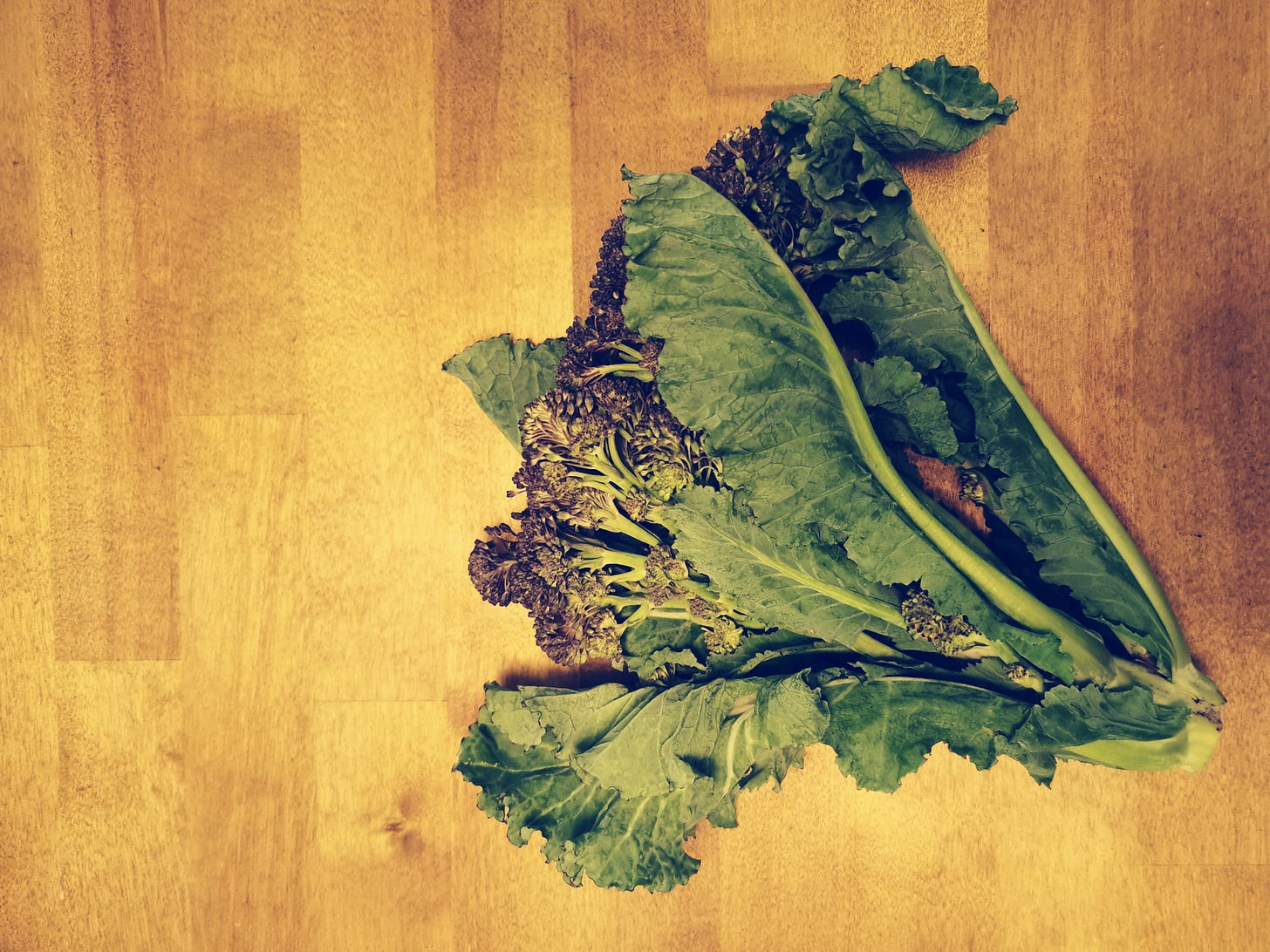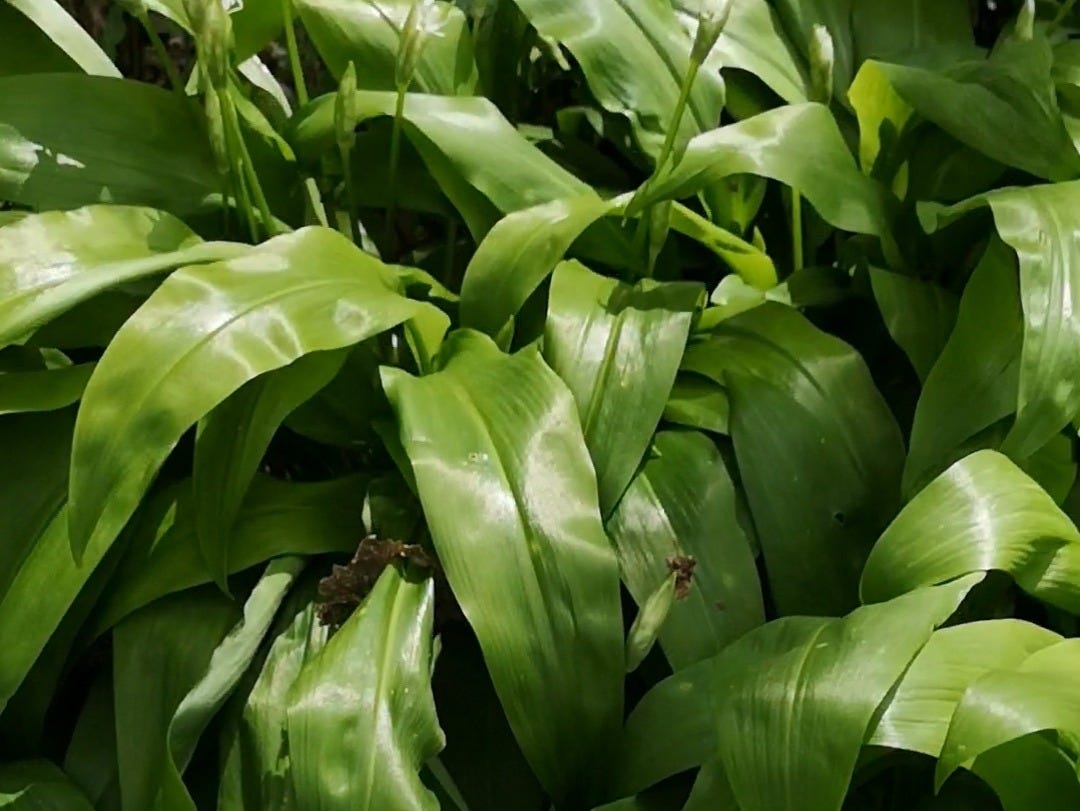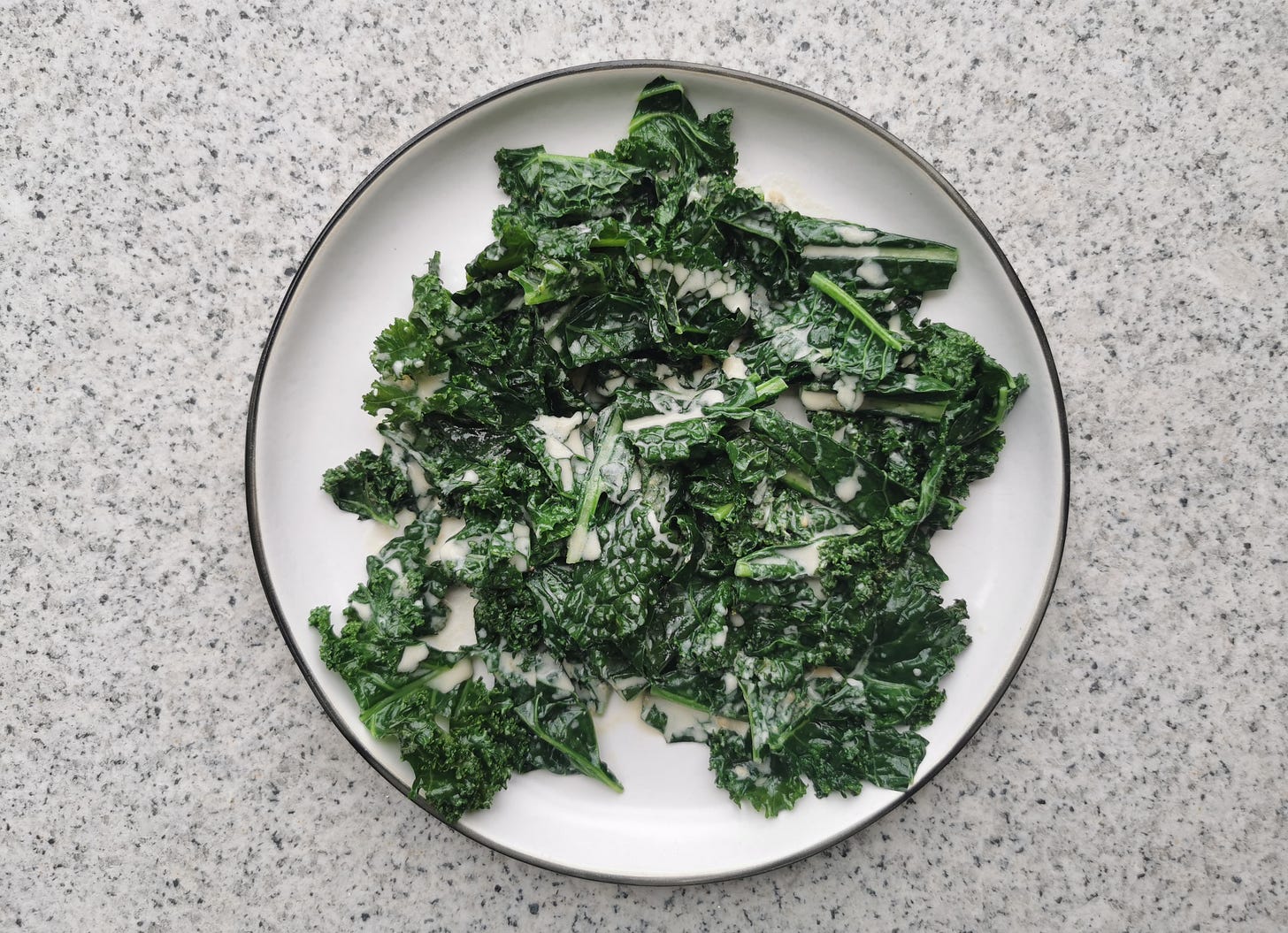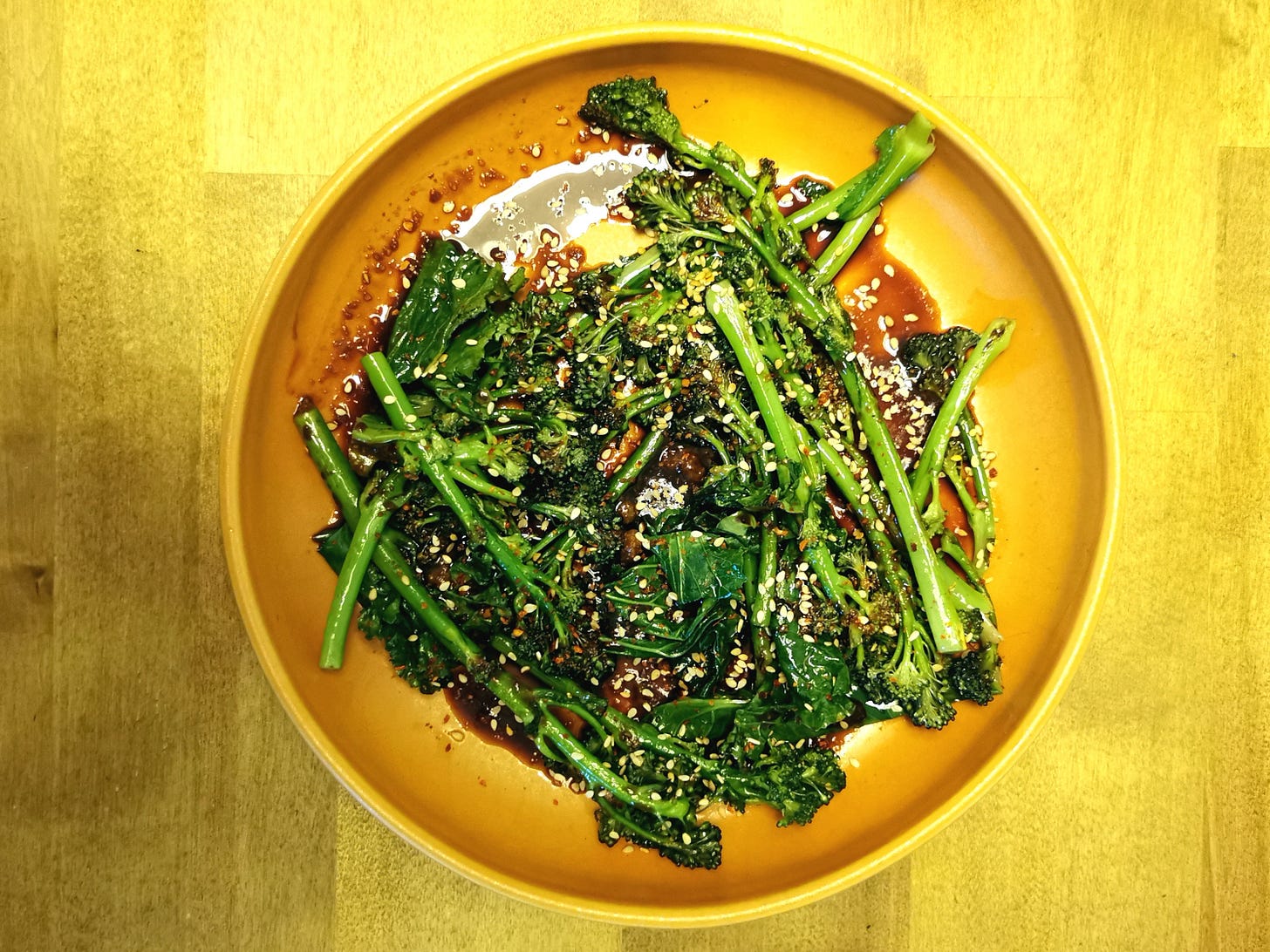The kid-at-Christmas-like anticipation of eating seasonally
And two recipes for a "green course" designed to get you eating seasonal greens
HEADS UP: this week, I am part of a series of “wine conversations” where six Substackers come together to chat about a wine-soaked topic.
We are talking about sustainable, organic and biodynamic certifications. Are they worth it? Do they work for consumers? Can you trust them to make better wine-buying decisions? Two conversations have dropped already with four more to come. Mine drops on Friday.
The six Substackers involved are:
- of (already dropped)
- of Down The Rabbit Hole (already dropped)
- of Brunello Bombshell
- of
Me
- of
If you want to buy better wine, this is an important topic. I’m excited to add my two cents to the conversation.
I saw it out of the corner of my eye during my run. A few crates of fruits and vegetables perched outside a shop and in one of them, purple sprouting broccoli.
PSB! My favourite of all the broccolis and not something I’d seen anywhere in Portugal before. In fact, my last taste of purple sprouting broccoli was before I left the UK over four years ago.
I couldn’t stop thinking about it during the run. Mile one was about how to steam then flash fry it. Mile three was thinking up sauces to go with it. At mile five I stopped outside that store, picked up a bunch, and carried it home like a prize. A medal of honour.
People talk a lot about how good it is to eat seasonally. They will talk about how much better it is for the environment. About how it tastes better (it’s not about January tomatoes). About how it’s cheaper not to fly food around the world so we can have strawberries in December.
All of that may be true, but the reality is that it’s very easy not to eat seasonally.
This data is a little old but in 2014, The Guardian reported that fewer than one in 10 Brits know what fruits and vegetables are in season when, despite 78% of them claiming to eat seasonally.
That, and supermarket fruit and vegetable offerings look suspiciously similar all year round. Sure, asparagus may come from Peru for 10 months of the year and from Britain for two, but you can still buy it 365 days a year.
I often used to buy out-of-season tomatoes or woolly citrus fruit flown in from halfway across the world but much of that changed when I subscribed to a local organic vegetable box. It was a start, but also a chore during the winter when the box seemed to be full of little more than four types of cabbage.
One of the biggest culture shocks during my move to Portugal was that I was forced to eat more seasonally because there was little choice. Unlike back in the UK, I am unable to procure every foodstuff I want, whenever I want. I have never, for instance, seen fresh tarragon here. Or until last week, purple sprouting broccoli.
And try finding a raspberry out of season.
If you shop at the local grocers or frutarías, you largely get what’s in season only. Supermarkets are a little more year-round but even they are more seasonal than what you find elsewhere.
That’s not to say Portugal is perfect. It still imports the equivalent of $5 billion worth of fruits and vegetables, much from our Spanish neighbours. But still, that pales into insignificance when you see other stats:
The US imports 60% of its fruits and 38% of its vegetables.
The UK imports 84% of its fruit and 44% of its vegetables.
It’s a little different here in Portugal. Because the country is full of small grocers focusing on home-grown, you feel the seasonality more. You can’t help but notice what’s in right now because the sidewalks are stacked high with crates filled with seasonal fruits and vegetables.
For anyone interested in food, this is both exciting and an education. An education because I’ve discovered things like Portgual grows both passionfruit and bananas (who knew!) And excitement because, if you’re eating seasonally, you may not have eaten that food in nearly a year.
Plus you know it’s not going to last forever. It’s the psychology of wanting what you can’t have. It’s why everyone goes bonkers in the UK for asparagus in May or why I’m considering a trip back to the UK in March. Ostensibly this is to see family but really it’s so I can pick wild garlic.
For my part, being forced to eat seasonally has made me a better, more resilient, more creative cook. If I can’t procure something because it’s not in season here, I’ll have to use something else. Or I’ll have to shelve that recipe until it is in season.
More than that, eating seasonally has turned me into a kid at Christmas. Except it’s even better because the excitement lasts year-round. Today, it’s purple sprouting broccoli. Next week, it’s whatever the frutaría brings on.
Yes, I am desperate for a decent tomato right now, I’ve not eaten one in five months. Yes, I wish I could eat a strawberry. That’s been eight months.
But I also know that when the time comes, it’ll be worth the wait.
So what do you do if you live somewhere that systematically prevents you from accessing fresh, local, seasonal produce? What if you no longer have a local grocer thanks to the nearby big box supermarket down the road selling Chilean kiwi fruits and Moroccan oranges?
Eating seasonally isn’t easy and that is on purpose. So you can only do what you can do with the time and resources you have available to you.
Some ideas:
Subscribe to a local vegetable box. This was the single biggest improvement I made in my eating seasonally quest back in the UK.
To help with the piles of green vegetables you will inevitably receive, consider introducing what I call a “green course” to your dinner. Green courses are inspired by the Mediterranean tradition of eating a salad or a vegetable dish before the main event. Lemony cavolo nero with parmesan. Broccoli with miso and chilli. Stir-fried thinly sliced cabbage with gochujang and soy sauce. Edamame with chilli oil. Once you have a few ways to prepare greens — and introduce them into your dinner— you’ll be happy to see yet another cabbage in your vegetable box.
Ferment, preserve, and jammify during the warmer months. On my list for this year:
Brined cherry tomatoes
Tomato passata
Pickled beetroot
Pickled green tomatoes
Pickles Portuguese style - cauliflower, carrots and cucumber spiked with chilli
Pickled gherkins
As much hot sauce as I can make
Preserved lemons (or you could try
’ preserved blood oranges)Orange marmalade
An obvious point but one worth making, if you’re a supermarket shopper, avoid the out-of-season imports.
If you can, grow your own. On my tiny balcony, I’ve grown cherry tomatoes, padrón peppers, chillies, beetroot, herbs, and arugula.
I highly recommend Joshua McFadden’s Six Seasons which tells you what’s in season when, and fantastic recipes to go with it. He also has the best advice:
Onto the recipes. These are “green course” recipes designed to kickstart your metabolism and get some vegetables into your belly. They also make great side dishes or light lunches (stick some flatbread on the side to make them more substantial).
Charred purple sprouting broccoli with miso and sesame
and
Cavolo nero with tahini-lemon sauce
As with many of my recipes, I’m pretty loose about quantities because you are not going to ruin it if you make too much or too little sauce for the size bunch of vegetables you have. These recipes are designed to be flexible. Trust me, you can’t fuck it up. Just make more sauce if you need it, or if you make too much, keep leftovers in the fridge for your next green course.
You can also swap out the greens for — naturally — what’s in season. I’ve included ideas below each recipe.
Both feed two people as a green course or side dish.
Charred purple sprouting broccoli with miso and sesame
Keep reading with a 7-day free trial
Subscribe to The Sauce to keep reading this post and get 7 days of free access to the full post archives.









